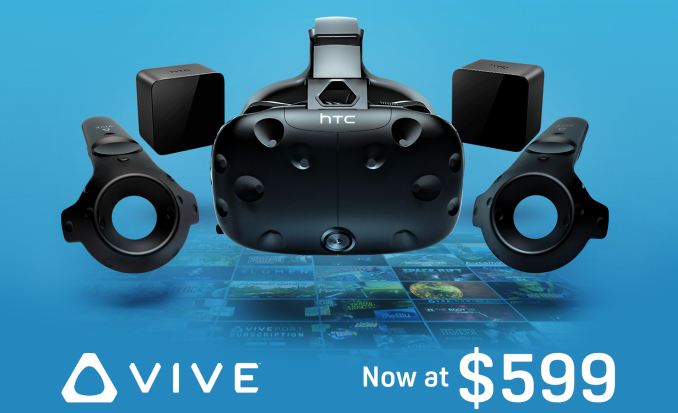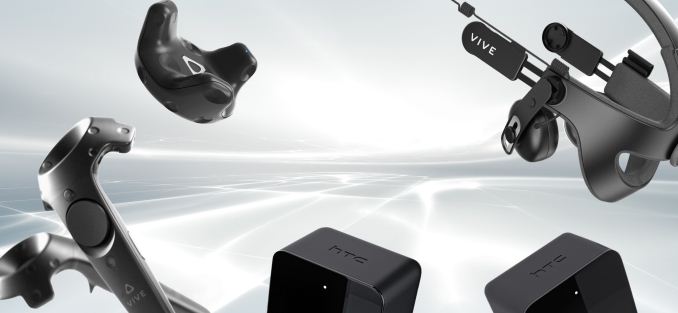HTC Permanently Cuts Price of Vive to $599
by Nate Oh on August 22, 2017 12:00 PM EST
On Monday, HTC announced a permanent Vive price reduction to $599, bringing the VR headset down from its original $799 launch price. The now-$599 standard HTC Vive kit includes the headset itself, two wireless controllers, two base stations, link box, earbuds, assorted connectors, and accessories. This move comes roughly a month after Oculus’ ‘Summer of Rift’ announcements that saw the Rift + Touch bundle permanently cut to $499.
Vive purchases come with complimentary copies of Google’s Tilt Brush, EverestVR, and Richie’s Plank Experience. In addition, HTC offers a one-month free trial to Viveport Subscription, where customers pay $6.99 a month for up to five titles to play. HTC also points out upcoming Vive exclusives, such as Fallout 4 VR and Doom VFR. In the background is natural compatibility with SteamVR, as Valve co-developed the Vive with HTC.
Currently, the Rift + Touch bundle is still available at its $399 summer sale price. However, the Rift + Touch bundle does require an additional $59 third sensor to achieve room-scale tracking, whereas the base Vive kit accomplishes this natively. In the same vein, the Vive price drop has not affected the separate $99 Deluxe Audio Strap. As noted last October, the Rift Touch controllers are more akin to “halves of gamepads”, as opposed to the Vive wands. Beyond our first looks with both the Vive and the Rift, both setups still emphasize different aspects of the VR experience despite offering similar capabilities.
While HTC has lowered the Vive’s price to $599, the Vive remains in pole position with respect to high-end VR market share. A few months earlier, research firm SuperData outlined its expectation that the Vive would outsell the Rift by 200,000 units. Now, despite the recent Rift price cuts, SuperData observes that HTC is still shipping more Vive units, although the ‘Summer of Rift’ sale did make up some ground. In the near future, HTC has the Daydream standalone Vive and Vive Knuckles in the pipeline, with the China-only Vive Standalone already shipping.
Nevertheless, price reductions for both Oculus Rift and HTC Vive bring high-end VR a step closer to widespread adoption. And for consumers, these continued price drops are the best news yet.
Related Reading
- HTC Announces Snapdragon 835-Based VIVE VR Headset for Chinese Market
- Oculus Announces Six Week Sale of $399 Rift + Touch Bundle
- Oculus Rift Launch Day News: New AMD & NVIDIA Drivers; Async Timewarp & Platform Restrictions Added To SDK
- Hands On With the Retail Oculus Rift: Countdown to Launch
- Oculus Touch Controllers Shipping In December for $199
- HTC & Intel Partner on WiGig Wireless for Vive VR Headset
- GDC 2017 Roundup: VR for All - Pico Neo CV, Tobii, & HTC
Source: HTC











34 Comments
View All Comments
fanofanand - Tuesday, August 22, 2017 - link
Still waiting for wireless. The new wi-fi standards should provide sufficient speed, now they just need to figure out how to make the batteries light and long-lasting. I have heard rumors already of next-gen devices being wireless. If VR is ever going to take off, they will need to ditch those wires.vanilla_gorilla - Tuesday, August 22, 2017 - link
There is a product called TPCast that converts the Vive to wireless. Reviews are very good and it actually just got FCC approval[1] so expect it soon.1 - https://www.reddit.com/r/oculus/comments/6s87vb/tp...
edzieba - Wednesday, August 23, 2017 - link
I'd avoid TPCast and similar products that repackage existing AV transceiver pairs (TPCast for example are using SiBeam's 2015-era WHD modules). Latency is critical for VR, and any latency added in the video link is latency that cannot be compensated for by timewarp/spacewarp late-sampling techniques. Every millisecond you add in link latency is a millisecond you remove from your render budget in order to stay within the 20ms motion-photons loop latency, and you're already starting from 11-14ms (SteamVR) to ~17ms (OVR) of CPU + GPU render budget in the first place. Add 5ms of link latency, and you need to drop to between 2/3 and 1/2 your scene complexity.CaedenV - Tuesday, August 22, 2017 - link
the larger issue than bandwidth is latency. There are plenty of wireless video streaming technologies that could work for this now from a bandwidth perspective, but they have a .5-1 sec latency... which is no good.But that said, I imagine some of the new 60ghz standards like 802.11ad should be able to cut that down dramatically... not sure if it would be enough, but it should help bring a more 'wire-like' expierence.
But then there is also the other end of the equation in that the wire also provides power. Headsets are already too heavy for extended use... the idea of adding battery weight to that equation is not to be taken 'lightly'.
JoeyJoJo123 - Tuesday, August 22, 2017 - link
VR was always a meme.Hurr Durr - Tuesday, August 22, 2017 - link
Just like ur mom.CaedenV - Tuesday, August 22, 2017 - link
VR will be great and wide-spread... just not at $500. The use-case for VR is just too limited. A flat screen is good for movies, work, games, work, and more work, but VR is mostly good for games... and even then only specific games. AR is also good for a wider variety of stuff, but still limited compared to a normal display.Still, I think we are going to see 2nd and 3rd gen products that are dramatically lighter, smaller, and cheaper to manufacture, and when they hit the $300 price point we will start seeing mass adoption (and games to match!). Should be good, but even cell phones didnt take off in a year or two. This is going to be a 5-10 year transition... and even then it will be to augment experiences, rather than replacing a traditional display.
bebby - Wednesday, August 23, 2017 - link
Just remember 3D Vision...although it was fun, it is over now and this is what will happen to VR for gaming. As long as only less than 10% of gamers use it, there is no biz reason for software developers to fully implement it in their games. Best 3D Vision game back then was Avator in terms of how it was thought for 3D from the very beginning. Still have not seen anything to compared to that. And 3D Vision was easy to use, wireless and light.Steven81 - Thursday, August 24, 2017 - link
For current applications it is good for gaming and movies.For future applications it will be good for educational purposes , social networking, visualizations...
AR is useless for everything at this point, and I fail to see anything it can do that either would be usefull or VR won't do it better. I never understood they hype around it.
As for the prce point. Agreed. We're finally nearing the natual price of a beta product that current VR is. Occulus Rift had it right, $300 ... and then lost it, killing the chance of VR in this decade.
By next decade it would be everywhere indeed ... the tech it is too premature, low quality for the time being...
Teutorix - Monday, August 28, 2017 - link
AR and VR are two completely different things. You can't use VR to supplement a real world environment. VR is for immersion, AR is for augmenting the real world the hint is in the name. I don't think they have much overlap outside of the underlying tech.In terms of actual uses beyond entertainment VR would be better for educational stuff yes, but AR has many uses to improve how people interact with the physical world, one potential use is warehousing for product tracking, though the feasibility is questionable if automated warehousing becomes ubiquitous.